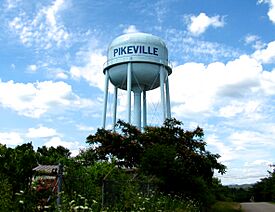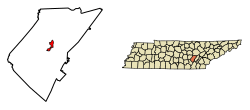Pikeville, Tennessee facts for kids
Quick facts for kids
Pikeville, Tennessee
|
|
|---|---|

Water tower in Pikeville
|
|

|
|
| Country | United States |
| State | Tennessee |
| County | Bledsoe |
| Established | 1816 |
| Incorporated | 1830 |
| Area | |
| • Total | 2.443 sq mi (6.326 km2) |
| • Land | 2.443 sq mi (6.326 km2) |
| • Water | 0.000 sq mi (0.000 km2) |
| Elevation | 860 ft (262 m) |
| Population
(2020)
|
|
| • Total | 1,824 |
| • Estimate
(2023)
|
1,880 |
| • Density | 769.74/sq mi (297.19/km2) |
| Time zone | UTC−6 (Central (CST)) |
| • Summer (DST) | UTC−5 (CDT) |
| ZIP Code |
37367
|
| Area code(s) | 423 |
| FIPS code | 47-58120 |
| GNIS feature ID | 1297464 |
| Sales tax | 7.0% |
Pikeville is a city in Tennessee, United States. It is the main town, also known as the county seat, of Bledsoe County. In 2020, about 1,824 people lived there.
Contents
History of Pikeville
The area where Pikeville is located, the Sequatchie River valley, used to belong to the Cherokee people. In 1805, they gave this land to the U.S. government as part of a deal called the Treaty of Tellico.
Bledsoe County was created in 1807. The county was named after a hunter named Anthony Bledsoe. At first, the county seat was a town called Madison.
Pikeville was started in 1816. The land was bought from Charles Love, who sold land for a living. No one is quite sure how Pikeville got its name. Some people think it was named after a famous explorer, Zebulon Pike. By 1818, Pikeville became the new county seat. The town officially became a city in 1830.
Later, a man named J.V. Wigle moved to Pikeville. He was an engineer from Michigan. He was the first person to bring electricity to the town. He also bottled Coca-Cola and made metal railings. He even invented things and got patents for them! His sons went to engineering school. One of his sons, Tom, helped build U.S. Route 127 near the town.
Geography and Location
Pikeville is located in the northern part of the Sequatchie Valley. This valley is a long, narrow, and fertile area that cuts through the southern Cumberland Plateau. The tall walls of the plateau, like Walden Ridge and Little Mountain, rise up on both sides of the valley. The Sequatchie River flows through the eastern part of Pikeville.
The main road in Pikeville is U.S. Route 127. This road connects Pikeville to Crossville to the north and Dunlap to the south. In Pikeville, US-127 splits. One part goes through the main downtown area, and another part goes around the city through newer shopping areas. State Route 30 also runs through Pikeville. It connects the city to Spencer and Fall Creek Falls State Park to the west, and Dayton to the east.
The city covers an area of about 12.118 square miles (31.38 square kilometers), and it's all land.
People of Pikeville
| Historical population | |||
|---|---|---|---|
| Census | Pop. | %± | |
| 1870 | 188 | — | |
| 1880 | 145 | −22.9% | |
| 1920 | 488 | — | |
| 1930 | 551 | 12.9% | |
| 1940 | 759 | 37.7% | |
| 1950 | 882 | 16.2% | |
| 1960 | 951 | 7.8% | |
| 1970 | 1,454 | 52.9% | |
| 1980 | 2,085 | 43.4% | |
| 1990 | 1,771 | −15.1% | |
| 2000 | 1,781 | 0.6% | |
| 2010 | 1,608 | −9.7% | |
| 2020 | 1,824 | 13.4% | |
| 2023 (est.) | 1,880 | 16.9% | |
| U.S. Decennial Census 2020 Census |
|||
In 2020, Pikeville had 1,824 people living there. There were 704 households and 434 families. Most of the people living in Pikeville are White (about 90.84%). Other groups include African American (2.19%), Native American (0.44%), and Asian (0.60%). About 2.36% of the population were Hispanic or Latino (of any race).
In 2010, there were 1,608 people in Pikeville. The population density was about 659 people per square mile.
Historic Buildings and Landmarks
Pikeville has several important historic buildings:
- John Bridgeman House - A historical landmark right in downtown Pikeville.
- Bellview School - This old schoolhouse was built in 1928. Today, it is used as a community center for local events.
- Bledsoe County Court House - The main building for the county government.
- Lincoln School - This school was built in the 1920s. It was one of many "Rosenwald schools" built to help educate African American children in the South.
- Pikeville Chapel African Methodist Episcopal Zion Church - This building started as a school in 1870. It became an AME Zion church in 1888.
- Dr. James A. Ross House - This was the home and office of Dr. James Ross, built around 1872. Now, it is the Museum of Bledsoe County History.
Notable People from Pikeville
Many interesting people have connections to Pikeville:
- Josiah M. Anderson - Born near Pikeville, he became a United States Congressman.
- Ramona Barnes (1938-2003) - An important state lawmaker in Alaska, she was born in Pikeville.
- James B. Frazier - He served as the Governor of Tennessee from 1903 to 1905 and later as a U.S. Senator.
- Theron Hale - A famous fiddler for the Grand Ole Opry, he was born in Pikeville in 1883.
- Jeanelle C. Moore - She was the First Lady of North Carolina.
- James G. Spears - A general during the Civil War.
Images for kids
See also
 In Spanish: Pikeville (Tennessee) para niños
In Spanish: Pikeville (Tennessee) para niños



